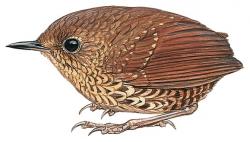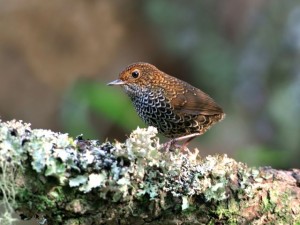Week 11 – 18 September 2016:
“Over Here! Look at Me! Over Here!”
Some birds are much better-known than others. Let me offer you the following evidence. If a biologist is keen to find scholarly publications addressing a particular topic or species, she might use an academic search engine called Web of Science. Using “Turdus merula,” the scientific name of the Eurasian Robin, as a search term will return 680 recent papers, and “Zonotrichia leucophrys,” the White-crowned Sparrow, will reveal 730 publications. Neither of those come close to “Anas platyrhynchos,” the Mallard duck, which will lead to 2,649 papers.
Pity, then, the poor Pygmy Wren-babbler. When I entered its scientific name, “Pnoepyga pusilla,” into Web of Science, I was offered just two publications. One was a 2013 paper which considered the relatedness of all members of the genus. The other was a 1991 publication about an entirely different type of bird.
It isn’t that the Pygmy Wren-babbler isn’t interesting. It is. At just 8 cm (3 inches) in length, and with no tail to speak of, this wren-babbler looks very much like an olive-brown egg adorned only by a tiny black beak and oversized legs. Seven subspecies are recognized, and some of these should probably considered as full species. Four distinctive forms are found on the islands of Indonesia alone. Despite being reasonably common in Nepal and China, the little bird just hasn’t been very well studied.
In 2016, Muhammad Nazri Janra of Andalas University in Indonesia and Richard Noske of Charles Darwin University in Australia published a brief note in the journal of the Indonesian Ornithologists’ Union. In November of 2009 Janra and his field crew were using mist-nets to capture birds 1,200 metres up the side of Mount Singgalang in the province of West Sumatra. The study targeted the Sumatran Cochoa, a beautiful and vulnerable songbird known only from Sumatra. While working along a woodland trail, Janra inadvertently flushed a Sumatran Pygmy Wren-babbler (Pnoepyga pusilla lepida) off its nest. The bird hopped along the ground, dragging one wing as though it was broken; it was an act of attempted deception. Janra was able to find the nest, even though it was very well concealed. Situated 50 cm (20 inches) above the ground, and constructed of plant fibres and covered with moss, it contained two white eggs.
The broken-wing display has been described most frequently from ground-dwelling shorebirds such as killdeer and other plovers. This strategy is surely designed to draw predators away from nests, although it requires great attention by the adult if it is to avoid being pounced upon. Not only was this the first observation of the broken-wing display by any member of the genus Pnoepyga, but it represents only the second published record of breeding by the species on Sumatra. It is a reasonably common bird on the world’s sixth-largest island, and yet we know almost nothing about it.
Their work required Janra and his team to investigate other locales. When they revisited the site where the broken-wing display had been witnessed a month earlier, they were unable to locate the nest nor spot any Pygmy Wren-babblers, and so it is not clear whether the nesting attempt had been successful.
It is through the dedication of researchers like Janra that we come to a better understanding of the world of birds. One observation at a time.
Janra, M. N. and R. Noske. 2015. Sumatran Pygmy Wren-babbler Pnoepyga pusilla lepida performing broken-wing distraction display near nest. Kukila 18:62-64.
Photocredits: Pygmy Wren-babbler – drawing of a Sumatran Pygmy Wren-babbler - http://www.hbw.com/species/pygmy-wren-babbler-pnoepyga-pusilla; http://www.birdingintaiwan.com/pygmywren-babbler.htm



